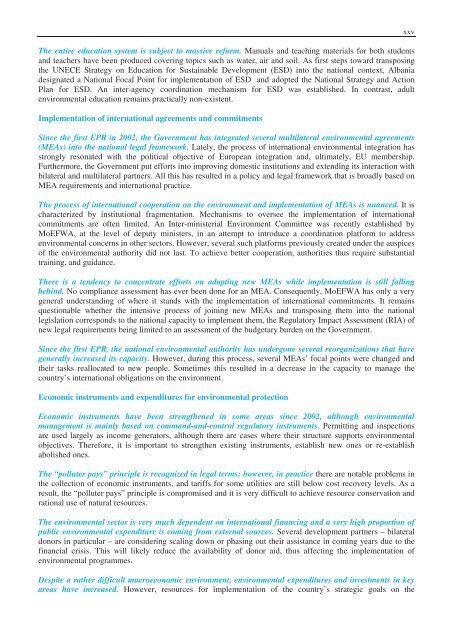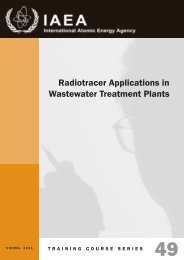Second Environmental Performance Review of Albania
Second Environmental Performance Review of Albania
Second Environmental Performance Review of Albania
You also want an ePaper? Increase the reach of your titles
YUMPU automatically turns print PDFs into web optimized ePapers that Google loves.
The entire education system is subject to massive reform. Manuals and teaching materials for both studentsand teachers have been produced covering topics such as water, air and soil. As first steps toward transposingthe UNECE Strategy on Education for Sustainable Development (ESD) into the national context, <strong>Albania</strong>designated a National Focal Point for implementation <strong>of</strong> ESD and adopted the National Strategy and ActionPlan for ESD. An inter-agency coordination mechanism for ESD was established. In contrast, adultenvironmental education remains practically non-existent.Implementation <strong>of</strong> international agreements and commitmentsSince the first EPR in 2002, the Government has integrated several multilateral environmental agreements(MEAs) into the national legal framework. Lately, the process <strong>of</strong> international environmental integration hasstrongly resonated with the political objective <strong>of</strong> European integration and, ultimately, EU membership.Furthermore, the Government put efforts into improving domestic institutions and extending its interaction withbilateral and multilateral partners. All this has resulted in a policy and legal framework that is broadly based onMEA requirements and international practice.The process <strong>of</strong> international cooperation on the environment and implementation <strong>of</strong> MEAs is nuanced. It ischaracterized by institutional fragmentation. Mechanisms to oversee the implementation <strong>of</strong> internationalcommitments are <strong>of</strong>ten limited. An Inter-ministerial Environment Committee was recently established byMoEFWA, at the level <strong>of</strong> deputy ministers, in an attempt to introduce a coordination platform to addressenvironmental concerns in other sectors. However, several such platforms previously created under the auspices<strong>of</strong> the environmental authority did not last. To achieve better cooperation, authorities thus require substantialtraining, and guidance.There is a tendency to concentrate efforts on adopting new MEAs while implementation is still fallingbehind. No compliance assessment has ever been done for an MEA. Consequently, MoEFWA has only a verygeneral understanding <strong>of</strong> where it stands with the implementation <strong>of</strong> international commitments. It remainsquestionable whether the intensive process <strong>of</strong> joining new MEAs and transposing them into the nationallegislation corresponds to the national capacity to implement them, the Regulatory Impact Assessment (RIA) <strong>of</strong>new legal requirements being limited to an assessment <strong>of</strong> the budgetary burden on the Government.Since the first EPR, the national environmental authority has undergone several reorganizations that havegenerally increased its capacity. However, during this process, several MEAs’ focal points were changed andtheir tasks reallocated to new people. Sometimes this resulted in a decrease in the capacity to manage thecountry’s international obligations on the environment.Economic instruments and expenditures for environmental protectionEconomic instruments have been strengthened in some areas since 2002, although environmentalmanagement is mainly based on command-and-control regulatory instruments. Permitting and inspectionsare used largely as income generators, although there are cases where their structure supports environmentalobjectives. Therefore, it is important to strengthen existing instruments, establish new ones or re-establishabolished ones.The “polluter pays” principle is recognized in legal terms; however, in practice there are notable problems inthe collection <strong>of</strong> economic instruments, and tariffs for some utilities are still below cost recovery levels. As aresult, the “polluter pays” principle is compromised and it is very difficult to achieve resource conservation andrational use <strong>of</strong> natural resources.The environmental sector is very much dependent on international financing and a very high proportion <strong>of</strong>public environmental expenditure is coming from external sources. Several development partners – bilateraldonors in particular – are considering scaling down or phasing out their assistance in coming years due to thefinancial crisis. This will likely reduce the availability <strong>of</strong> donor aid, thus affecting the implementation <strong>of</strong>environmental programmes.Despite a rather difficult macroeconomic environment, environmental expenditures and investments in keyareas have increased. However, resources for implementation <strong>of</strong> the country’s strategic goals on thexxv
















